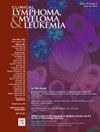慢性骨髓纤维化患者停用鲁索利替尼后疾病表型显著影响预后
IF 2.7
4区 医学
Q2 HEMATOLOGY
引用次数: 0
摘要
在骨髓纤维化(MF)患者中,鲁索利替尼停药后的总生存期(OS)较差,白血病转化、克隆进化和血小板减少是导致预后恶化的主要因素。患者和方法:为了评估慢性病患者停药后疾病表型对预后的影响,我们对“ruxolitinib”研究(NCT06516406)进行了一项亚分析,该研究目前包括1055名在现实生活中接受ruxolitinib治疗的MF患者。结果:中位随访3.3年后,397例患者在慢性期停止了鲁索利替尼治疗。治疗结束时,208例患者(52.4%)出现严重细胞减少表型(定义为血小板< 100 × 109/L和/或血红蛋白< 8 g/dL);在其余的189例骨髓增生性患者中,97例(51.3%)无细胞减少症,92例(48.7%)仅轻度贫血(血红蛋白在8 - 10 g/dL之间)。总体而言,175例(44.1%)患者脾肿大(肋缘下≥10cm可触及)。鲁索利替尼停药后,严重细胞减少性患者3年OS为33.4%,骨髓增生性患者3年OS为54.4% (P < 0.001);在调整了风险类别后,这一点得到了证实。非细胞减少性和轻度贫血患者的OS相当(P = 0.73)。脾肿大患者的OS明显低于非脾肿大患者(OS: 33.5% vs. 51.6% P = 0.01)。脾肿大证实其对骨髓增生性MF患者的OS有不良预后影响(60.7%比44.5%,P = 0.05)。在严重细胞减少症患者中,脾肿大的存在不影响OS (41.7% vs. 26.1%, P = 0.26)。结论:骨髓增殖性MF患者的细胞减少表型和脾肿大是鲁索利替尼停药后预后的关键决定因素。本文章由计算机程序翻译,如有差异,请以英文原文为准。
Disease Phenotype Significantly Influences the Outcome After Discontinuation of Ruxolitinib in Chronic Phase Myelofibrosis
Introduction
In patients with myelofibrosis (MF), overall survival (OS) after ruxolitinib discontinuation is poor, with leukemic transformation, clonal evolution and thrombocytopenia as the main factors worsening prognosis.
Patients and Methods
To assess the impact of disease phenotype on outcome after ruxolitinib discontinuation in chronic phase patients, we performed a sub-analysis of the “RUX-MF” study (NCT06516406), which now includes 1055 MF patients who received ruxolitinib in a real-life context.
Results
After a median follow-up of 3.3 years, 397 patients discontinued ruxolitinib therapy while in chronic phase. At treatment end, 208 patients (52.4%) had a severely cytopenic phenotype (defined as platelets < 100 × 109/L and/or hemoglobin < 8 g/dL); among the remaining myeloproliferative 189 patients, 97 had no cytopenia (51.3%) and 92 (48.7%) had mild anemia only (hemoglobin between 8 and 10 g/dL). Overall, 175 patients (44.1%) had a large splenomegaly (palpable at ≥ 10 cm below costal margin).
After ruxolitinib discontinuation, 3-year OS was 33.4% in severely cytopenic and 54.4% in myeloproliferative patients (P < .001); this was confirmed after adjustment for risk categories. Noncytopenic and mildly anemic patients had comparable OS (P = .73). Patients with large splenomegaly had significantly poorer OS compared to nonsplenomegalic patients (OS: 33.5% vs. 51.6% P = .01). Large splenomegaly confirmed its negative prognostic impact on OS of patients with myeloproliferative MF (60.7% vs. 44.5%, P = .05). In patients with severe cytopenia, the presence of a large splenomegaly did not influence OS (41.7% vs. 26.1%, P = .26).
Conclusions
Cytopenic phenotype and large splenomegaly in myeloproliferative MF are key prognostic determinants of outcome after ruxolitinib discontinuation.
求助全文
通过发布文献求助,成功后即可免费获取论文全文。
去求助
来源期刊

Clinical Lymphoma, Myeloma & Leukemia
ONCOLOGY-HEMATOLOGY
CiteScore
2.70
自引率
3.70%
发文量
1606
审稿时长
26 days
期刊介绍:
Clinical Lymphoma, Myeloma & Leukemia is a peer-reviewed monthly journal that publishes original articles describing various aspects of clinical and translational research of lymphoma, myeloma and leukemia. Clinical Lymphoma, Myeloma & Leukemia is devoted to articles on detection, diagnosis, prevention, and treatment of lymphoma, myeloma, leukemia and related disorders including macroglobulinemia, amyloidosis, and plasma-cell dyscrasias. The main emphasis is on recent scientific developments in all areas related to lymphoma, myeloma and leukemia. Specific areas of interest include clinical research and mechanistic approaches; drug sensitivity and resistance; gene and antisense therapy; pathology, markers, and prognostic indicators; chemoprevention strategies; multimodality therapy; and integration of various approaches.
 求助内容:
求助内容: 应助结果提醒方式:
应助结果提醒方式:


